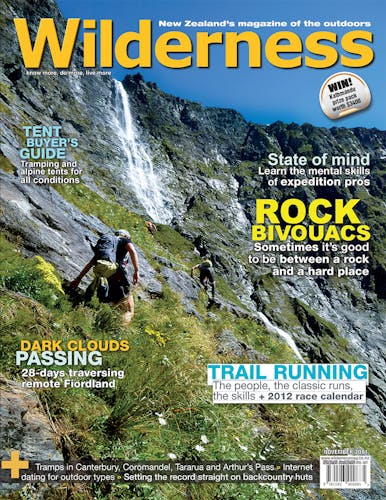- Time
- 8-9hr return
- Grade
- Easy
- Accom.
- Mitre Flats Hut, 20 bunks
- Access
- From Upper Waingawa Road, approximately 10km from Masterton
- Map
- BP34
Mitre Flats Hut, Tararua Forest Park
Three friends, all city dwellers keen for fresh air, conversation and a whisky at the end of a long day’s walk. We were looking for a track close to Wellington, a hut with a fire and a tramp that tested our muscles a bit but not too much. Mitre Flats seemed to fit the bill.
We parked the car at The Pines, a farm road end, and walked down a long driveway and across farmland to where the track started in earnest. After crossing a couple of stiles we were into it, tramping along a goat track in the bush. It was still another 10 minutes before a DOC sign showed that we had officially entered Tararua Forest Park.
The track to Mitre Flats follows the Waingawa River and is named Barra Track after Bert Barra, a renowned deer culler. Decades of working in the bush weren’t enough for Barra; on retirement he lived alone in a powerless hut in the area until his death at age 93.
We found Barra Track well worn by weather and foot traffic. In places there was little more to it than mud, stones and tree roots. We had expected a gentle walk and instead found ourselves crawling in places where it became abruptly vertical.
The Barra does eventually come down to the river, where a rope wire bridge gives easy access to Mitre Flats. Built in 1988, the hut sat lonely looking in the broad clearing. It was a good size though, with the usual cast iron stove, drying rack and bunks. A serviced hut, it also had in-built gas burners to save you the trouble of lugging one in. But it was too early for us to enjoy any of this and we had decided to push on and attempt to climb Mitre (1571m), the highest peak in the Tararua Range and another three hours from the flats.
We didn’t have much time after our walk in, so scoffed our packed lunch before heading off again. The guide book said there were no really steep sections on the walk up but immediately we encountered one stretch that matched our criteria for really steep. We rushed up, puffing, to find the track evened out and we could go at a better pace. The track cut through beech and podocarp, and as we got higher the bush became stranger, the trees gnarled and covered with moss – like a forest from Grimm Brothers. Really though, I wasn’t paying too much attention to the forest, by then my only interest was in reaching the top.
We passed through a section of leatherwoods. Once out of it and standing on a scree slope, we could see how far we still had to go. Mitre was off in the distance, further than we had hoped. It sat behind the slightly smaller Peggy’s Peak. Getting there meant tramping higher up the scree to the top of Peggy’s and then over a short saddle that led to the Mitre.
We did more scree climbing, trudging higher and higher with the odd break to admire the views. With Peggy’s Peak still to go, we figured we had another hour to the top of Mitre, and then about three to get down – which would mean a descent in the dark. A change in the weather settled it. As Mitre became shrouded in cloud, we realised it would no longer give us a vantage point and we began the walk back.
By the time we arrived at the hut, rain had set in. We built up the fire and took a cleansing dip in the Waingawa. That evening with candles lit, we had that post-tramp whisky – sipping from tin mugs and talking through our attempt on Mitre – the one that got away and steeper and steeper with each retelling.
We walked out along the Barra Track in grey and drizzly weather. Looking back, the mountain was just a dark patch in the clouds.
It was disappointing to leave it unclimbed, but at least we have an excuse to come back.
– John Summers







